Energy Poverty and Sustainable Development
VerifiedAdded on 2020/05/16
|23
|3748
|160
AI Summary
This assignment focuses on analyzing various research methodologies suitable for investigating energy poverty and its relationship to sustainable development goals. It delves into both quantitative and qualitative approaches, referencing relevant literature and frameworks like mixed methods, policy coherence, and energy poverty measurement techniques. The objective is to critically evaluate different methods and their applicability in understanding the complex dynamics of energy poverty within a sustainable development framework.
Contribute Materials
Your contribution can guide someone’s learning journey. Share your
documents today.
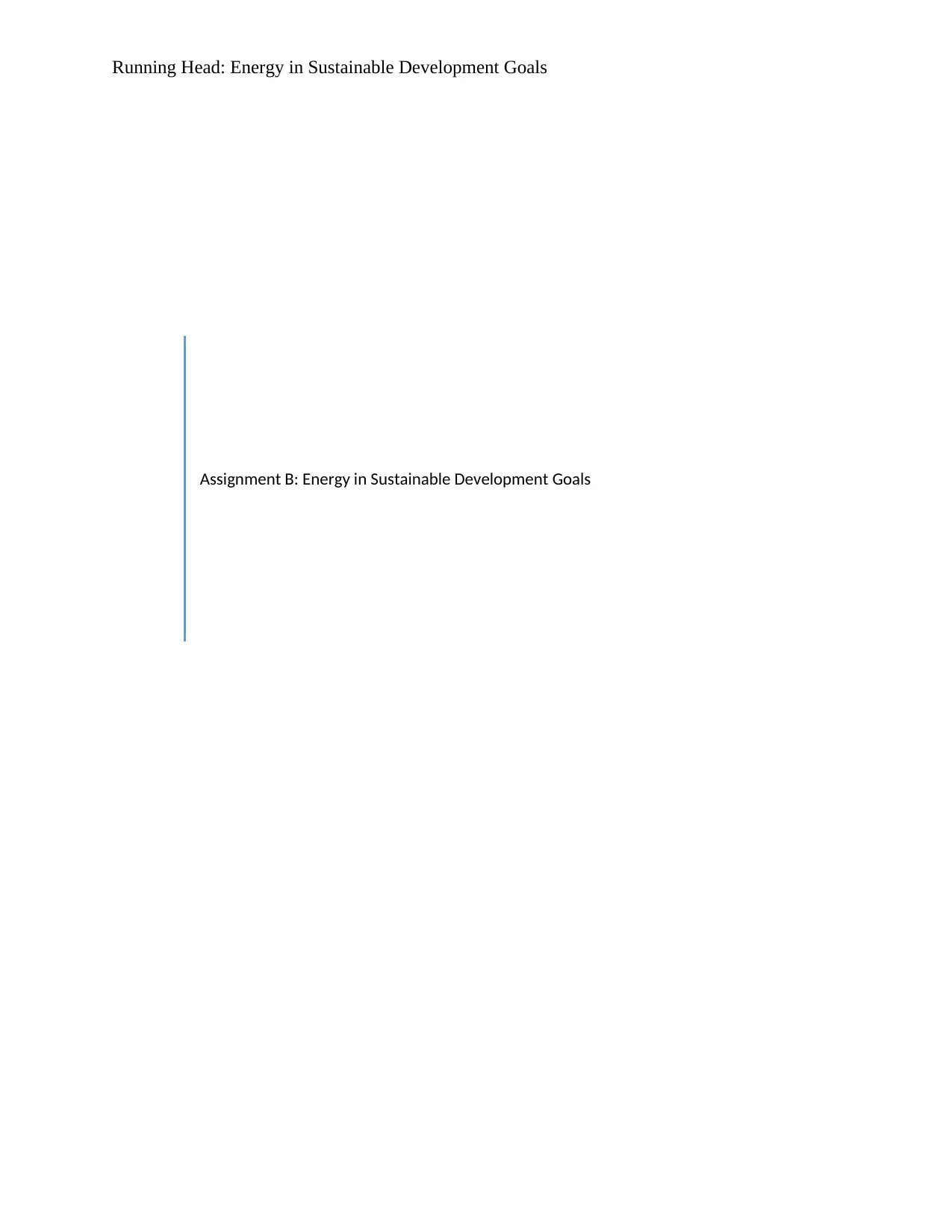
Running Head: Energy in Sustainable Development Goals
Assignment B: Energy in Sustainable Development Goals
Assignment B: Energy in Sustainable Development Goals
Secure Best Marks with AI Grader
Need help grading? Try our AI Grader for instant feedback on your assignments.
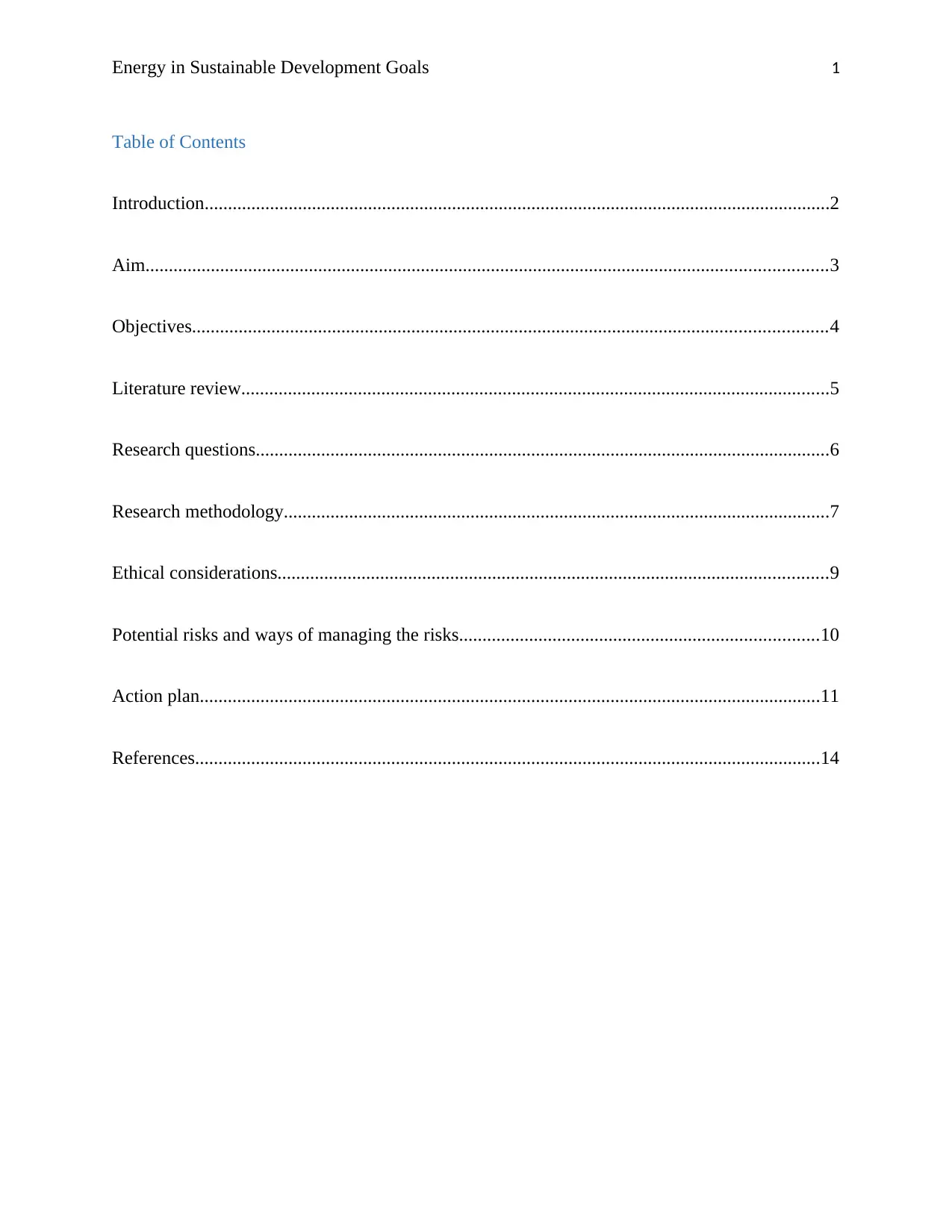
Energy in Sustainable Development Goals 1
Table of Contents
Introduction......................................................................................................................................2
Aim..................................................................................................................................................3
Objectives........................................................................................................................................4
Literature review..............................................................................................................................5
Research questions...........................................................................................................................6
Research methodology.....................................................................................................................7
Ethical considerations......................................................................................................................9
Potential risks and ways of managing the risks.............................................................................10
Action plan.....................................................................................................................................11
References......................................................................................................................................14
Table of Contents
Introduction......................................................................................................................................2
Aim..................................................................................................................................................3
Objectives........................................................................................................................................4
Literature review..............................................................................................................................5
Research questions...........................................................................................................................6
Research methodology.....................................................................................................................7
Ethical considerations......................................................................................................................9
Potential risks and ways of managing the risks.............................................................................10
Action plan.....................................................................................................................................11
References......................................................................................................................................14
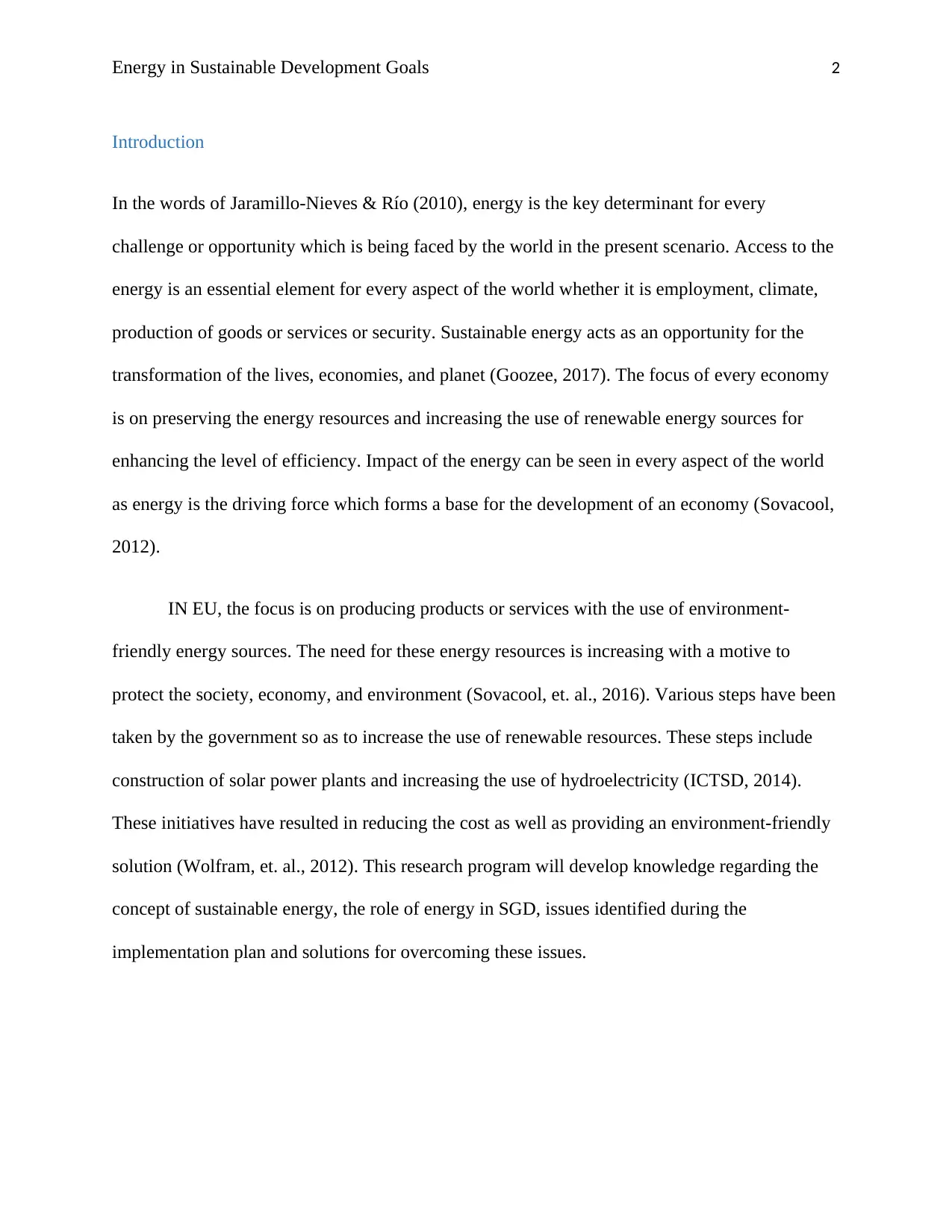
Energy in Sustainable Development Goals 2
Introduction
In the words of Jaramillo-Nieves & Río (2010), energy is the key determinant for every
challenge or opportunity which is being faced by the world in the present scenario. Access to the
energy is an essential element for every aspect of the world whether it is employment, climate,
production of goods or services or security. Sustainable energy acts as an opportunity for the
transformation of the lives, economies, and planet (Goozee, 2017). The focus of every economy
is on preserving the energy resources and increasing the use of renewable energy sources for
enhancing the level of efficiency. Impact of the energy can be seen in every aspect of the world
as energy is the driving force which forms a base for the development of an economy (Sovacool,
2012).
IN EU, the focus is on producing products or services with the use of environment-
friendly energy sources. The need for these energy resources is increasing with a motive to
protect the society, economy, and environment (Sovacool, et. al., 2016). Various steps have been
taken by the government so as to increase the use of renewable resources. These steps include
construction of solar power plants and increasing the use of hydroelectricity (ICTSD, 2014).
These initiatives have resulted in reducing the cost as well as providing an environment-friendly
solution (Wolfram, et. al., 2012). This research program will develop knowledge regarding the
concept of sustainable energy, the role of energy in SGD, issues identified during the
implementation plan and solutions for overcoming these issues.
Introduction
In the words of Jaramillo-Nieves & Río (2010), energy is the key determinant for every
challenge or opportunity which is being faced by the world in the present scenario. Access to the
energy is an essential element for every aspect of the world whether it is employment, climate,
production of goods or services or security. Sustainable energy acts as an opportunity for the
transformation of the lives, economies, and planet (Goozee, 2017). The focus of every economy
is on preserving the energy resources and increasing the use of renewable energy sources for
enhancing the level of efficiency. Impact of the energy can be seen in every aspect of the world
as energy is the driving force which forms a base for the development of an economy (Sovacool,
2012).
IN EU, the focus is on producing products or services with the use of environment-
friendly energy sources. The need for these energy resources is increasing with a motive to
protect the society, economy, and environment (Sovacool, et. al., 2016). Various steps have been
taken by the government so as to increase the use of renewable resources. These steps include
construction of solar power plants and increasing the use of hydroelectricity (ICTSD, 2014).
These initiatives have resulted in reducing the cost as well as providing an environment-friendly
solution (Wolfram, et. al., 2012). This research program will develop knowledge regarding the
concept of sustainable energy, the role of energy in SGD, issues identified during the
implementation plan and solutions for overcoming these issues.
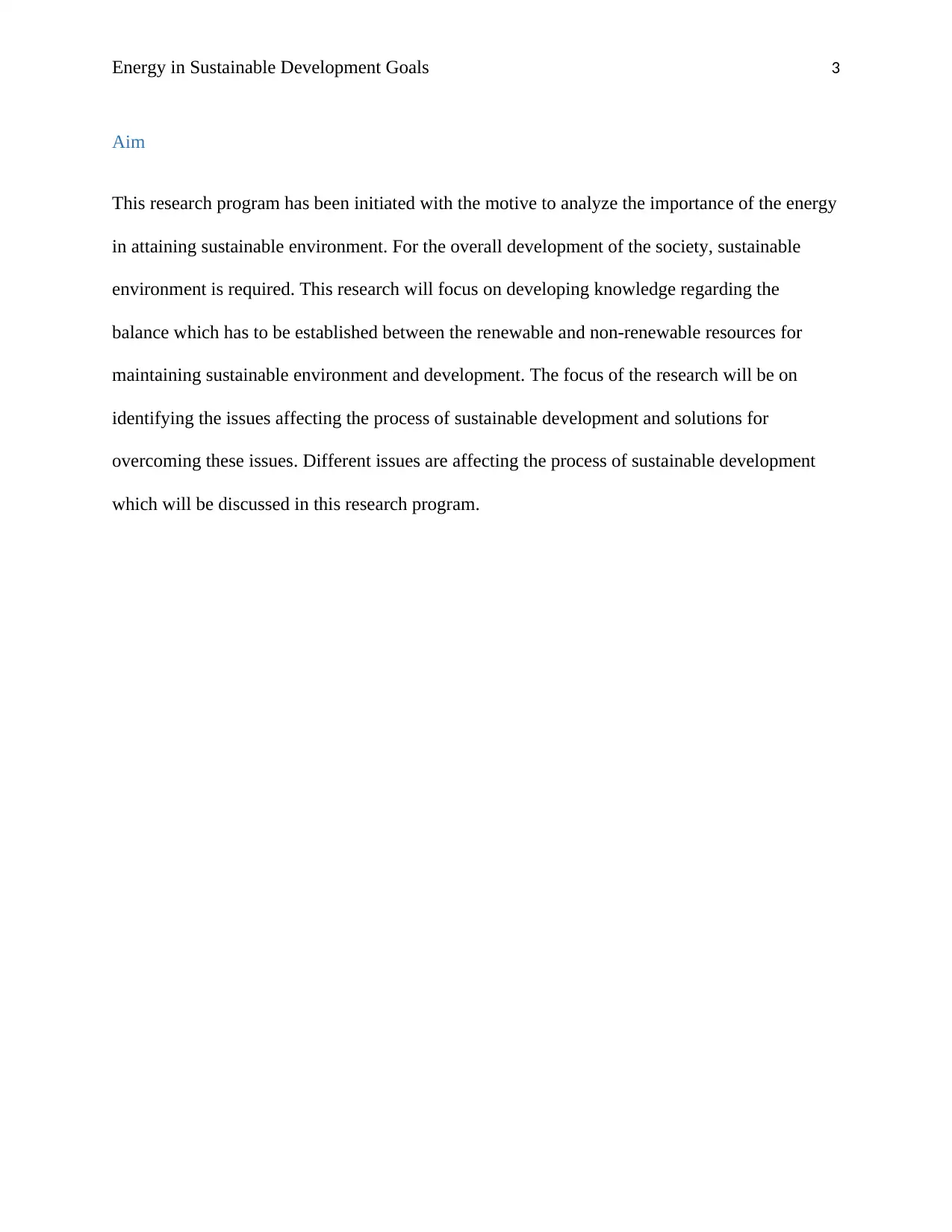
Energy in Sustainable Development Goals 3
Aim
This research program has been initiated with the motive to analyze the importance of the energy
in attaining sustainable environment. For the overall development of the society, sustainable
environment is required. This research will focus on developing knowledge regarding the
balance which has to be established between the renewable and non-renewable resources for
maintaining sustainable environment and development. The focus of the research will be on
identifying the issues affecting the process of sustainable development and solutions for
overcoming these issues. Different issues are affecting the process of sustainable development
which will be discussed in this research program.
Aim
This research program has been initiated with the motive to analyze the importance of the energy
in attaining sustainable environment. For the overall development of the society, sustainable
environment is required. This research will focus on developing knowledge regarding the
balance which has to be established between the renewable and non-renewable resources for
maintaining sustainable environment and development. The focus of the research will be on
identifying the issues affecting the process of sustainable development and solutions for
overcoming these issues. Different issues are affecting the process of sustainable development
which will be discussed in this research program.
Paraphrase This Document
Need a fresh take? Get an instant paraphrase of this document with our AI Paraphraser

Energy in Sustainable Development Goals 4
Objectives
Objectives have been divided into the primary and secondary objectives so as to assemble the
required data with a better approach. This research will discuss the importance of the sustainable
development and its impact on the society, environment, and economy. The primary objective of
this research program is to develop knowledge regarding the role of energy in sustainable
development goals. Secondary objectives of this research program are to analyze the various
issues acting as barriers to attaining sustainability and solutions for resolving the issue.
Objectives
Objectives have been divided into the primary and secondary objectives so as to assemble the
required data with a better approach. This research will discuss the importance of the sustainable
development and its impact on the society, environment, and economy. The primary objective of
this research program is to develop knowledge regarding the role of energy in sustainable
development goals. Secondary objectives of this research program are to analyze the various
issues acting as barriers to attaining sustainability and solutions for resolving the issue.
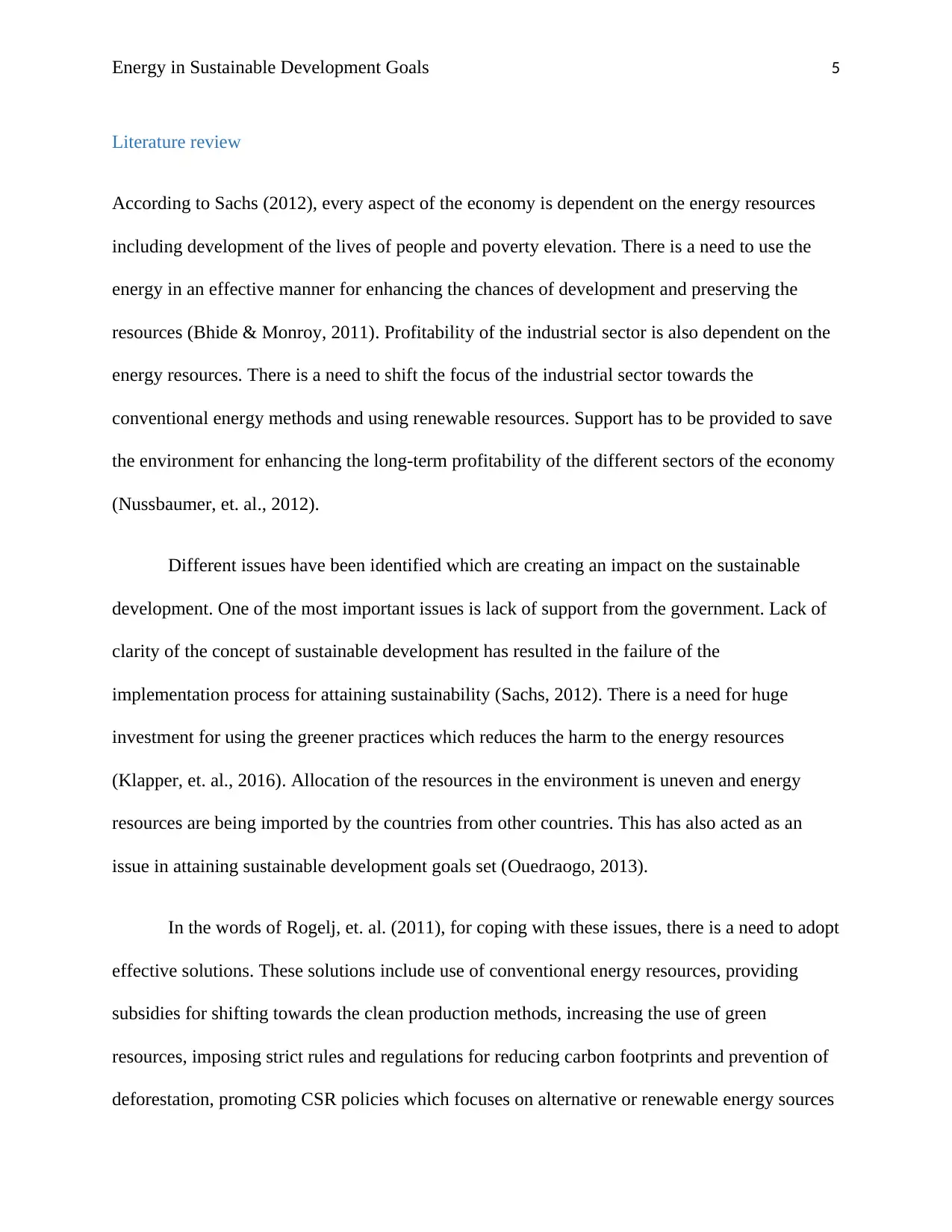
Energy in Sustainable Development Goals 5
Literature review
According to Sachs (2012), every aspect of the economy is dependent on the energy resources
including development of the lives of people and poverty elevation. There is a need to use the
energy in an effective manner for enhancing the chances of development and preserving the
resources (Bhide & Monroy, 2011). Profitability of the industrial sector is also dependent on the
energy resources. There is a need to shift the focus of the industrial sector towards the
conventional energy methods and using renewable resources. Support has to be provided to save
the environment for enhancing the long-term profitability of the different sectors of the economy
(Nussbaumer, et. al., 2012).
Different issues have been identified which are creating an impact on the sustainable
development. One of the most important issues is lack of support from the government. Lack of
clarity of the concept of sustainable development has resulted in the failure of the
implementation process for attaining sustainability (Sachs, 2012). There is a need for huge
investment for using the greener practices which reduces the harm to the energy resources
(Klapper, et. al., 2016). Allocation of the resources in the environment is uneven and energy
resources are being imported by the countries from other countries. This has also acted as an
issue in attaining sustainable development goals set (Ouedraogo, 2013).
In the words of Rogelj, et. al. (2011), for coping with these issues, there is a need to adopt
effective solutions. These solutions include use of conventional energy resources, providing
subsidies for shifting towards the clean production methods, increasing the use of green
resources, imposing strict rules and regulations for reducing carbon footprints and prevention of
deforestation, promoting CSR policies which focuses on alternative or renewable energy sources
Literature review
According to Sachs (2012), every aspect of the economy is dependent on the energy resources
including development of the lives of people and poverty elevation. There is a need to use the
energy in an effective manner for enhancing the chances of development and preserving the
resources (Bhide & Monroy, 2011). Profitability of the industrial sector is also dependent on the
energy resources. There is a need to shift the focus of the industrial sector towards the
conventional energy methods and using renewable resources. Support has to be provided to save
the environment for enhancing the long-term profitability of the different sectors of the economy
(Nussbaumer, et. al., 2012).
Different issues have been identified which are creating an impact on the sustainable
development. One of the most important issues is lack of support from the government. Lack of
clarity of the concept of sustainable development has resulted in the failure of the
implementation process for attaining sustainability (Sachs, 2012). There is a need for huge
investment for using the greener practices which reduces the harm to the energy resources
(Klapper, et. al., 2016). Allocation of the resources in the environment is uneven and energy
resources are being imported by the countries from other countries. This has also acted as an
issue in attaining sustainable development goals set (Ouedraogo, 2013).
In the words of Rogelj, et. al. (2011), for coping with these issues, there is a need to adopt
effective solutions. These solutions include use of conventional energy resources, providing
subsidies for shifting towards the clean production methods, increasing the use of green
resources, imposing strict rules and regulations for reducing carbon footprints and prevention of
deforestation, promoting CSR policies which focuses on alternative or renewable energy sources
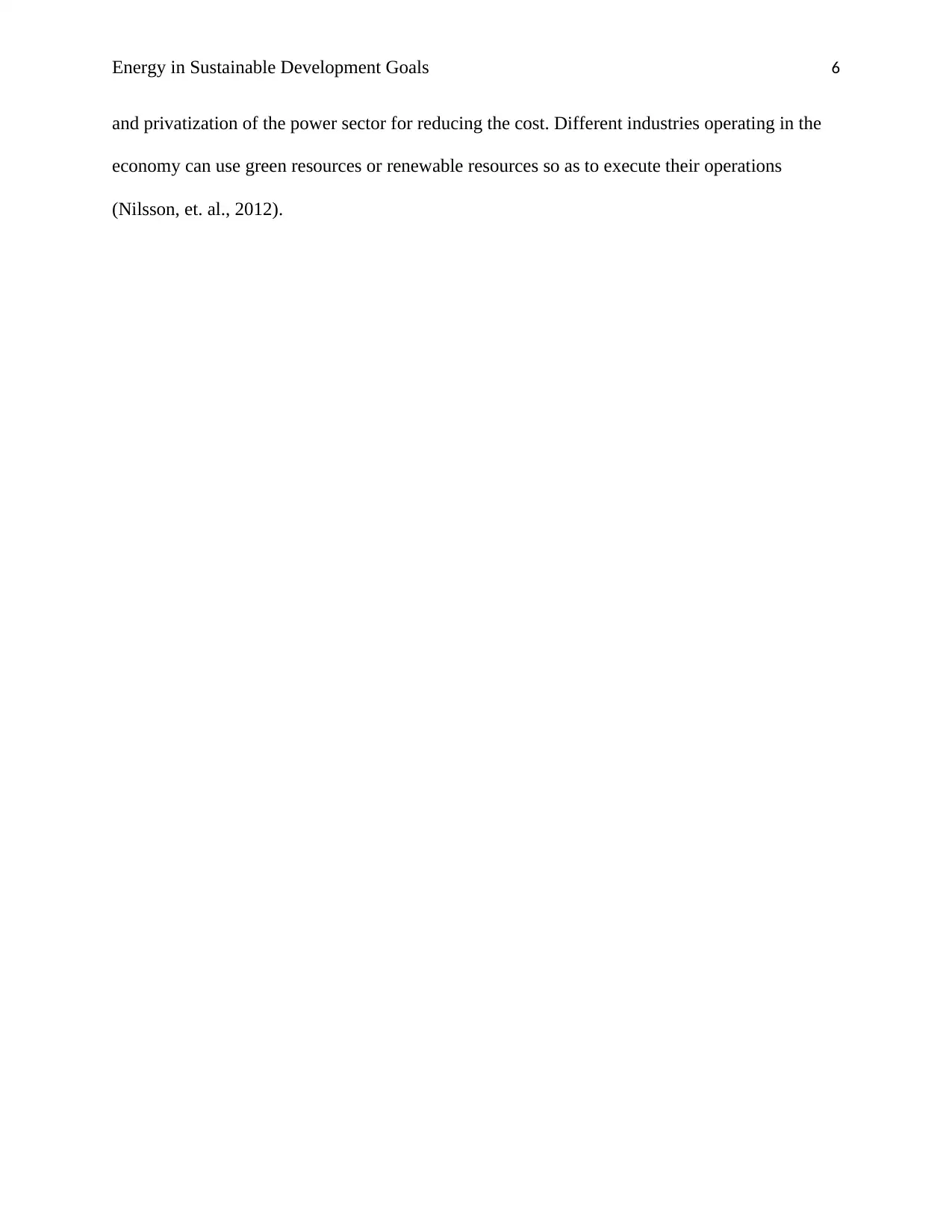
Energy in Sustainable Development Goals 6
and privatization of the power sector for reducing the cost. Different industries operating in the
economy can use green resources or renewable resources so as to execute their operations
(Nilsson, et. al., 2012).
and privatization of the power sector for reducing the cost. Different industries operating in the
economy can use green resources or renewable resources so as to execute their operations
(Nilsson, et. al., 2012).
Secure Best Marks with AI Grader
Need help grading? Try our AI Grader for instant feedback on your assignments.
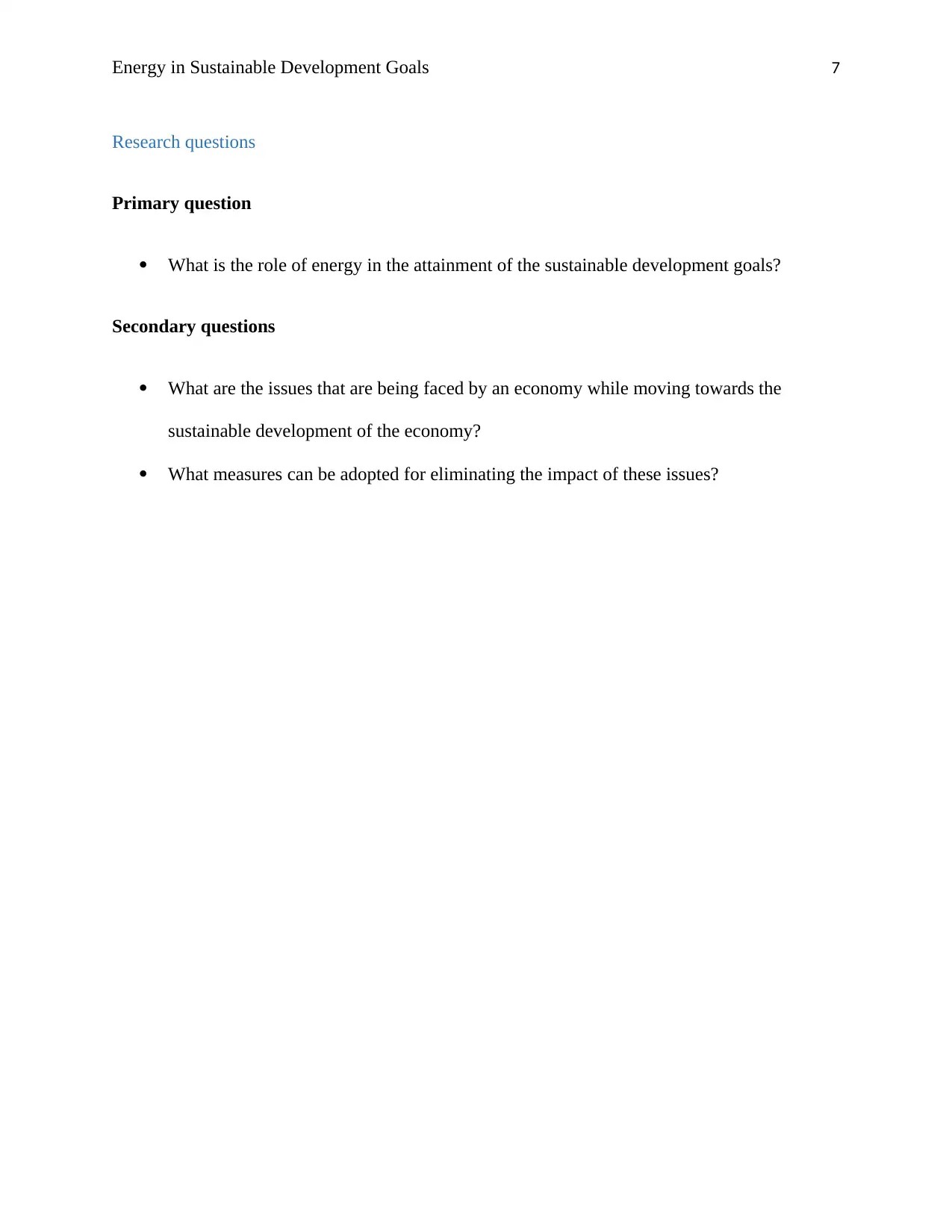
Energy in Sustainable Development Goals 7
Research questions
Primary question
What is the role of energy in the attainment of the sustainable development goals?
Secondary questions
What are the issues that are being faced by an economy while moving towards the
sustainable development of the economy?
What measures can be adopted for eliminating the impact of these issues?
Research questions
Primary question
What is the role of energy in the attainment of the sustainable development goals?
Secondary questions
What are the issues that are being faced by an economy while moving towards the
sustainable development of the economy?
What measures can be adopted for eliminating the impact of these issues?
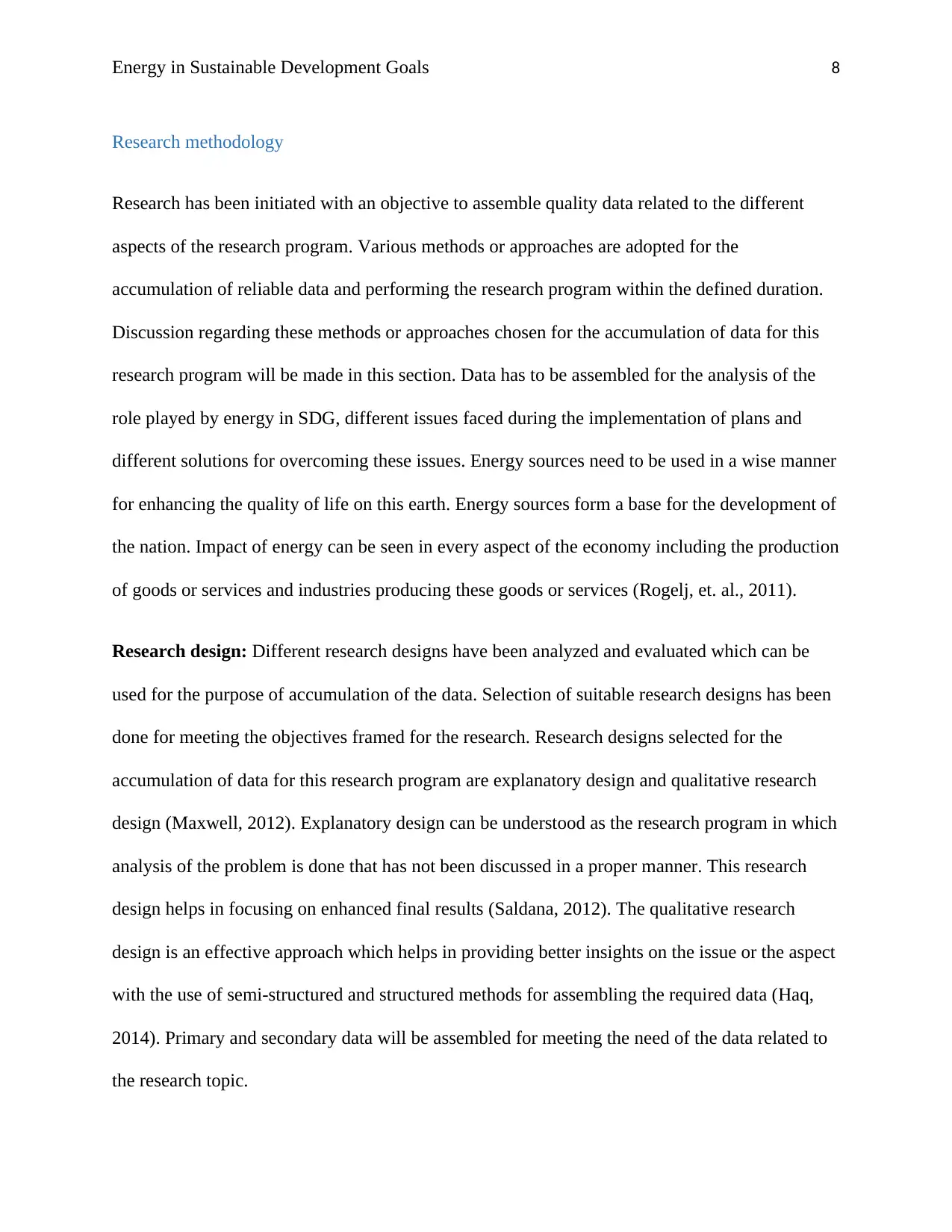
Energy in Sustainable Development Goals 8
Research methodology
Research has been initiated with an objective to assemble quality data related to the different
aspects of the research program. Various methods or approaches are adopted for the
accumulation of reliable data and performing the research program within the defined duration.
Discussion regarding these methods or approaches chosen for the accumulation of data for this
research program will be made in this section. Data has to be assembled for the analysis of the
role played by energy in SDG, different issues faced during the implementation of plans and
different solutions for overcoming these issues. Energy sources need to be used in a wise manner
for enhancing the quality of life on this earth. Energy sources form a base for the development of
the nation. Impact of energy can be seen in every aspect of the economy including the production
of goods or services and industries producing these goods or services (Rogelj, et. al., 2011).
Research design: Different research designs have been analyzed and evaluated which can be
used for the purpose of accumulation of the data. Selection of suitable research designs has been
done for meeting the objectives framed for the research. Research designs selected for the
accumulation of data for this research program are explanatory design and qualitative research
design (Maxwell, 2012). Explanatory design can be understood as the research program in which
analysis of the problem is done that has not been discussed in a proper manner. This research
design helps in focusing on enhanced final results (Saldana, 2012). The qualitative research
design is an effective approach which helps in providing better insights on the issue or the aspect
with the use of semi-structured and structured methods for assembling the required data (Haq,
2014). Primary and secondary data will be assembled for meeting the need of the data related to
the research topic.
Research methodology
Research has been initiated with an objective to assemble quality data related to the different
aspects of the research program. Various methods or approaches are adopted for the
accumulation of reliable data and performing the research program within the defined duration.
Discussion regarding these methods or approaches chosen for the accumulation of data for this
research program will be made in this section. Data has to be assembled for the analysis of the
role played by energy in SDG, different issues faced during the implementation of plans and
different solutions for overcoming these issues. Energy sources need to be used in a wise manner
for enhancing the quality of life on this earth. Energy sources form a base for the development of
the nation. Impact of energy can be seen in every aspect of the economy including the production
of goods or services and industries producing these goods or services (Rogelj, et. al., 2011).
Research design: Different research designs have been analyzed and evaluated which can be
used for the purpose of accumulation of the data. Selection of suitable research designs has been
done for meeting the objectives framed for the research. Research designs selected for the
accumulation of data for this research program are explanatory design and qualitative research
design (Maxwell, 2012). Explanatory design can be understood as the research program in which
analysis of the problem is done that has not been discussed in a proper manner. This research
design helps in focusing on enhanced final results (Saldana, 2012). The qualitative research
design is an effective approach which helps in providing better insights on the issue or the aspect
with the use of semi-structured and structured methods for assembling the required data (Haq,
2014). Primary and secondary data will be assembled for meeting the need of the data related to
the research topic.
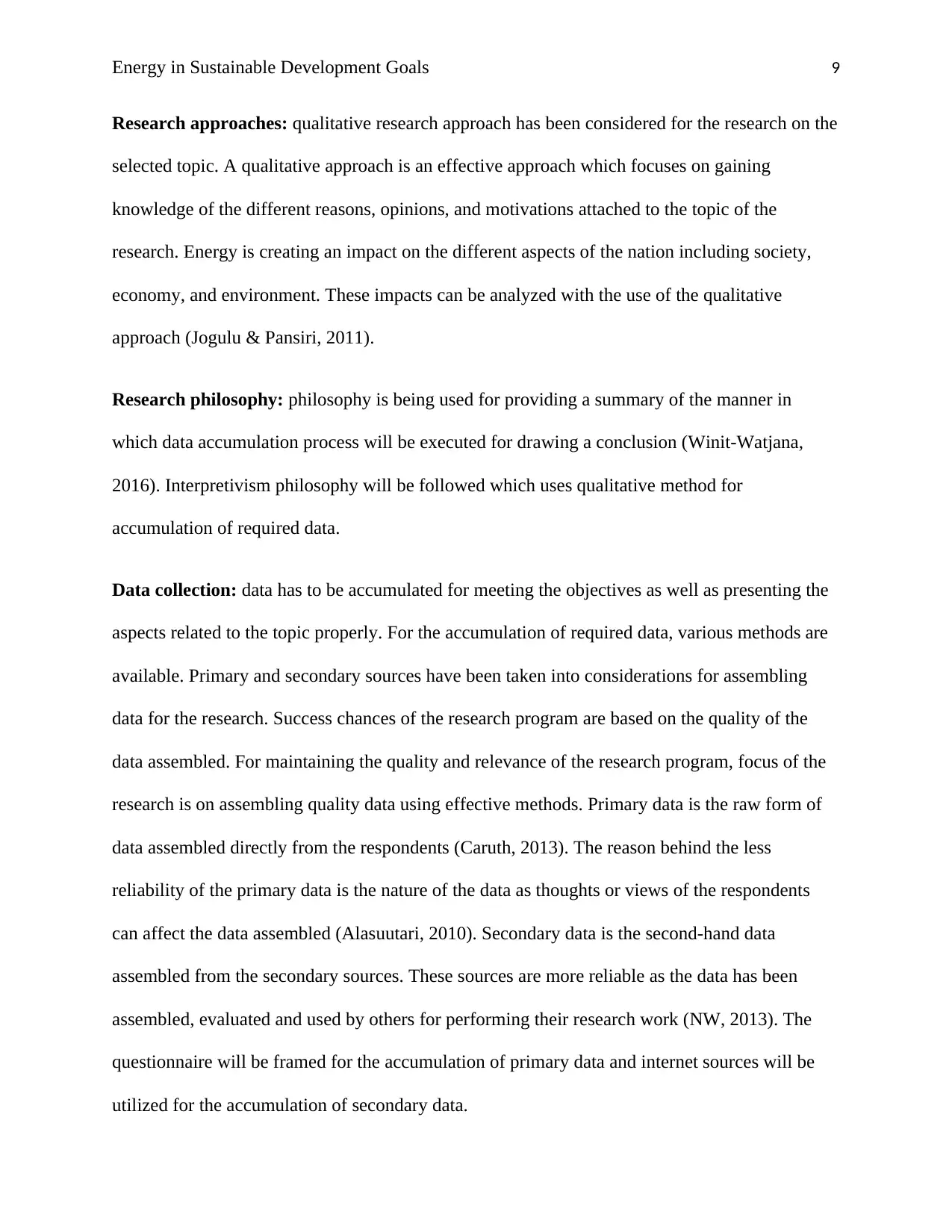
Energy in Sustainable Development Goals 9
Research approaches: qualitative research approach has been considered for the research on the
selected topic. A qualitative approach is an effective approach which focuses on gaining
knowledge of the different reasons, opinions, and motivations attached to the topic of the
research. Energy is creating an impact on the different aspects of the nation including society,
economy, and environment. These impacts can be analyzed with the use of the qualitative
approach (Jogulu & Pansiri, 2011).
Research philosophy: philosophy is being used for providing a summary of the manner in
which data accumulation process will be executed for drawing a conclusion (Winit-Watjana,
2016). Interpretivism philosophy will be followed which uses qualitative method for
accumulation of required data.
Data collection: data has to be accumulated for meeting the objectives as well as presenting the
aspects related to the topic properly. For the accumulation of required data, various methods are
available. Primary and secondary sources have been taken into considerations for assembling
data for the research. Success chances of the research program are based on the quality of the
data assembled. For maintaining the quality and relevance of the research program, focus of the
research is on assembling quality data using effective methods. Primary data is the raw form of
data assembled directly from the respondents (Caruth, 2013). The reason behind the less
reliability of the primary data is the nature of the data as thoughts or views of the respondents
can affect the data assembled (Alasuutari, 2010). Secondary data is the second-hand data
assembled from the secondary sources. These sources are more reliable as the data has been
assembled, evaluated and used by others for performing their research work (NW, 2013). The
questionnaire will be framed for the accumulation of primary data and internet sources will be
utilized for the accumulation of secondary data.
Research approaches: qualitative research approach has been considered for the research on the
selected topic. A qualitative approach is an effective approach which focuses on gaining
knowledge of the different reasons, opinions, and motivations attached to the topic of the
research. Energy is creating an impact on the different aspects of the nation including society,
economy, and environment. These impacts can be analyzed with the use of the qualitative
approach (Jogulu & Pansiri, 2011).
Research philosophy: philosophy is being used for providing a summary of the manner in
which data accumulation process will be executed for drawing a conclusion (Winit-Watjana,
2016). Interpretivism philosophy will be followed which uses qualitative method for
accumulation of required data.
Data collection: data has to be accumulated for meeting the objectives as well as presenting the
aspects related to the topic properly. For the accumulation of required data, various methods are
available. Primary and secondary sources have been taken into considerations for assembling
data for the research. Success chances of the research program are based on the quality of the
data assembled. For maintaining the quality and relevance of the research program, focus of the
research is on assembling quality data using effective methods. Primary data is the raw form of
data assembled directly from the respondents (Caruth, 2013). The reason behind the less
reliability of the primary data is the nature of the data as thoughts or views of the respondents
can affect the data assembled (Alasuutari, 2010). Secondary data is the second-hand data
assembled from the secondary sources. These sources are more reliable as the data has been
assembled, evaluated and used by others for performing their research work (NW, 2013). The
questionnaire will be framed for the accumulation of primary data and internet sources will be
utilized for the accumulation of secondary data.
Paraphrase This Document
Need a fresh take? Get an instant paraphrase of this document with our AI Paraphraser
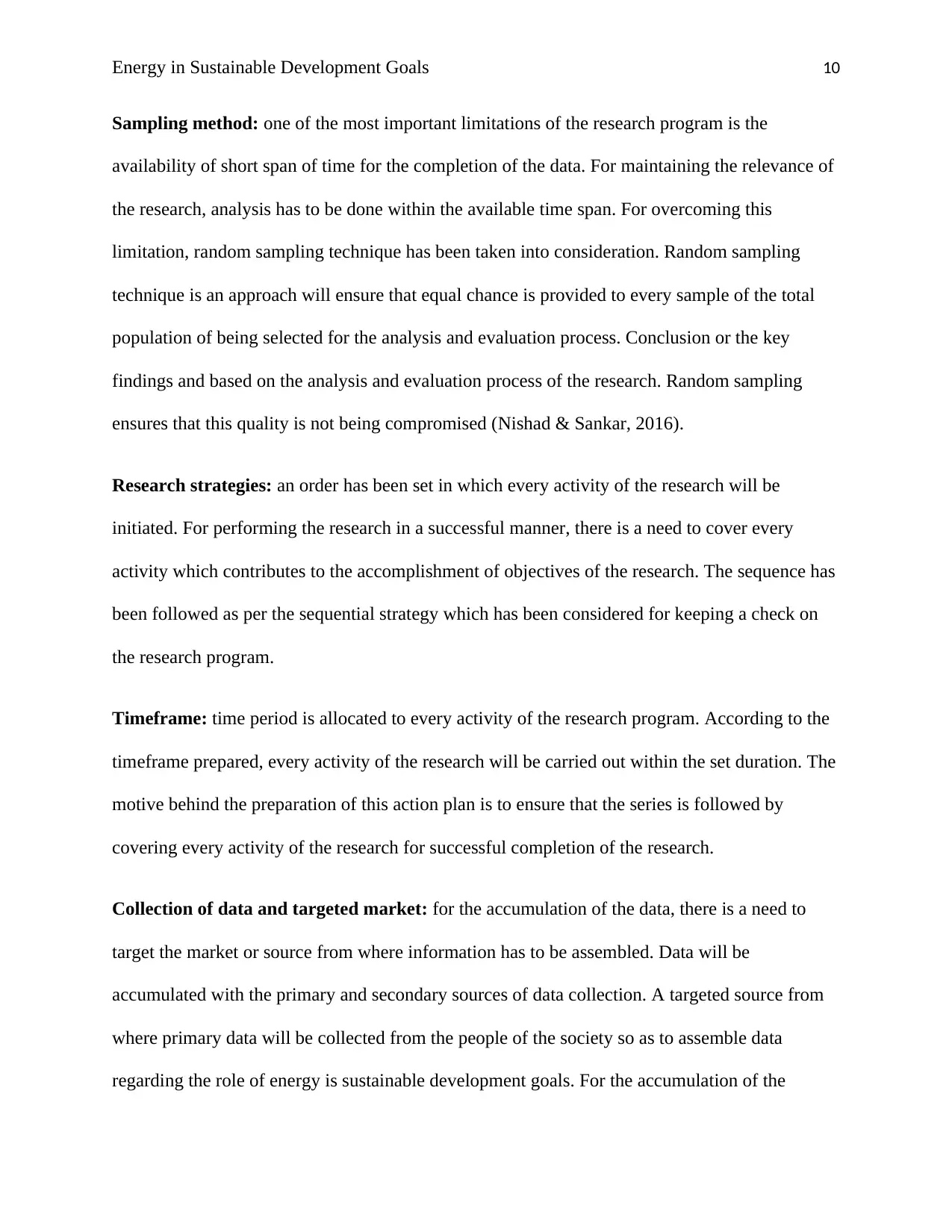
Energy in Sustainable Development Goals 10
Sampling method: one of the most important limitations of the research program is the
availability of short span of time for the completion of the data. For maintaining the relevance of
the research, analysis has to be done within the available time span. For overcoming this
limitation, random sampling technique has been taken into consideration. Random sampling
technique is an approach will ensure that equal chance is provided to every sample of the total
population of being selected for the analysis and evaluation process. Conclusion or the key
findings and based on the analysis and evaluation process of the research. Random sampling
ensures that this quality is not being compromised (Nishad & Sankar, 2016).
Research strategies: an order has been set in which every activity of the research will be
initiated. For performing the research in a successful manner, there is a need to cover every
activity which contributes to the accomplishment of objectives of the research. The sequence has
been followed as per the sequential strategy which has been considered for keeping a check on
the research program.
Timeframe: time period is allocated to every activity of the research program. According to the
timeframe prepared, every activity of the research will be carried out within the set duration. The
motive behind the preparation of this action plan is to ensure that the series is followed by
covering every activity of the research for successful completion of the research.
Collection of data and targeted market: for the accumulation of the data, there is a need to
target the market or source from where information has to be assembled. Data will be
accumulated with the primary and secondary sources of data collection. A targeted source from
where primary data will be collected from the people of the society so as to assemble data
regarding the role of energy is sustainable development goals. For the accumulation of the
Sampling method: one of the most important limitations of the research program is the
availability of short span of time for the completion of the data. For maintaining the relevance of
the research, analysis has to be done within the available time span. For overcoming this
limitation, random sampling technique has been taken into consideration. Random sampling
technique is an approach will ensure that equal chance is provided to every sample of the total
population of being selected for the analysis and evaluation process. Conclusion or the key
findings and based on the analysis and evaluation process of the research. Random sampling
ensures that this quality is not being compromised (Nishad & Sankar, 2016).
Research strategies: an order has been set in which every activity of the research will be
initiated. For performing the research in a successful manner, there is a need to cover every
activity which contributes to the accomplishment of objectives of the research. The sequence has
been followed as per the sequential strategy which has been considered for keeping a check on
the research program.
Timeframe: time period is allocated to every activity of the research program. According to the
timeframe prepared, every activity of the research will be carried out within the set duration. The
motive behind the preparation of this action plan is to ensure that the series is followed by
covering every activity of the research for successful completion of the research.
Collection of data and targeted market: for the accumulation of the data, there is a need to
target the market or source from where information has to be assembled. Data will be
accumulated with the primary and secondary sources of data collection. A targeted source from
where primary data will be collected from the people of the society so as to assemble data
regarding the role of energy is sustainable development goals. For the accumulation of the
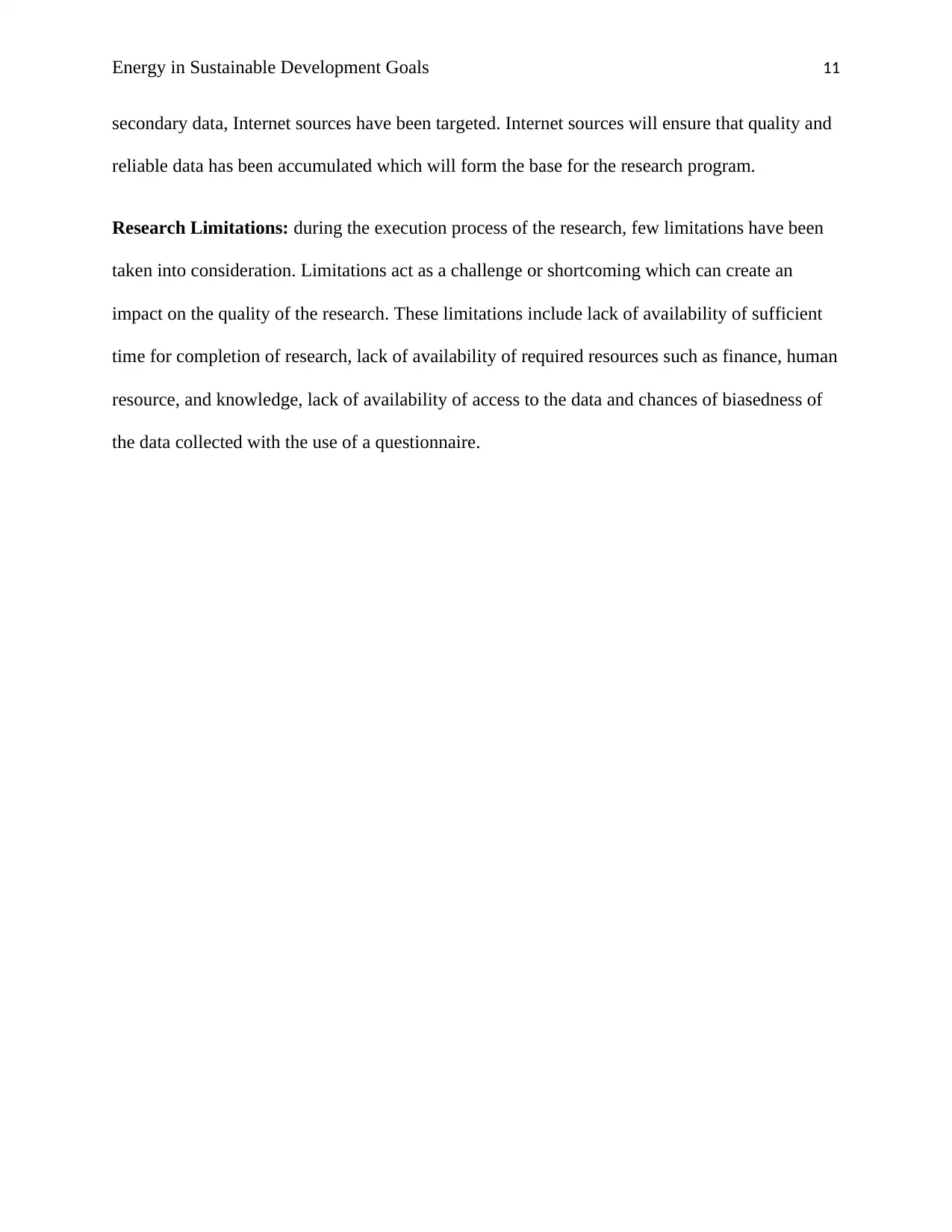
Energy in Sustainable Development Goals 11
secondary data, Internet sources have been targeted. Internet sources will ensure that quality and
reliable data has been accumulated which will form the base for the research program.
Research Limitations: during the execution process of the research, few limitations have been
taken into consideration. Limitations act as a challenge or shortcoming which can create an
impact on the quality of the research. These limitations include lack of availability of sufficient
time for completion of research, lack of availability of required resources such as finance, human
resource, and knowledge, lack of availability of access to the data and chances of biasedness of
the data collected with the use of a questionnaire.
secondary data, Internet sources have been targeted. Internet sources will ensure that quality and
reliable data has been accumulated which will form the base for the research program.
Research Limitations: during the execution process of the research, few limitations have been
taken into consideration. Limitations act as a challenge or shortcoming which can create an
impact on the quality of the research. These limitations include lack of availability of sufficient
time for completion of research, lack of availability of required resources such as finance, human
resource, and knowledge, lack of availability of access to the data and chances of biasedness of
the data collected with the use of a questionnaire.
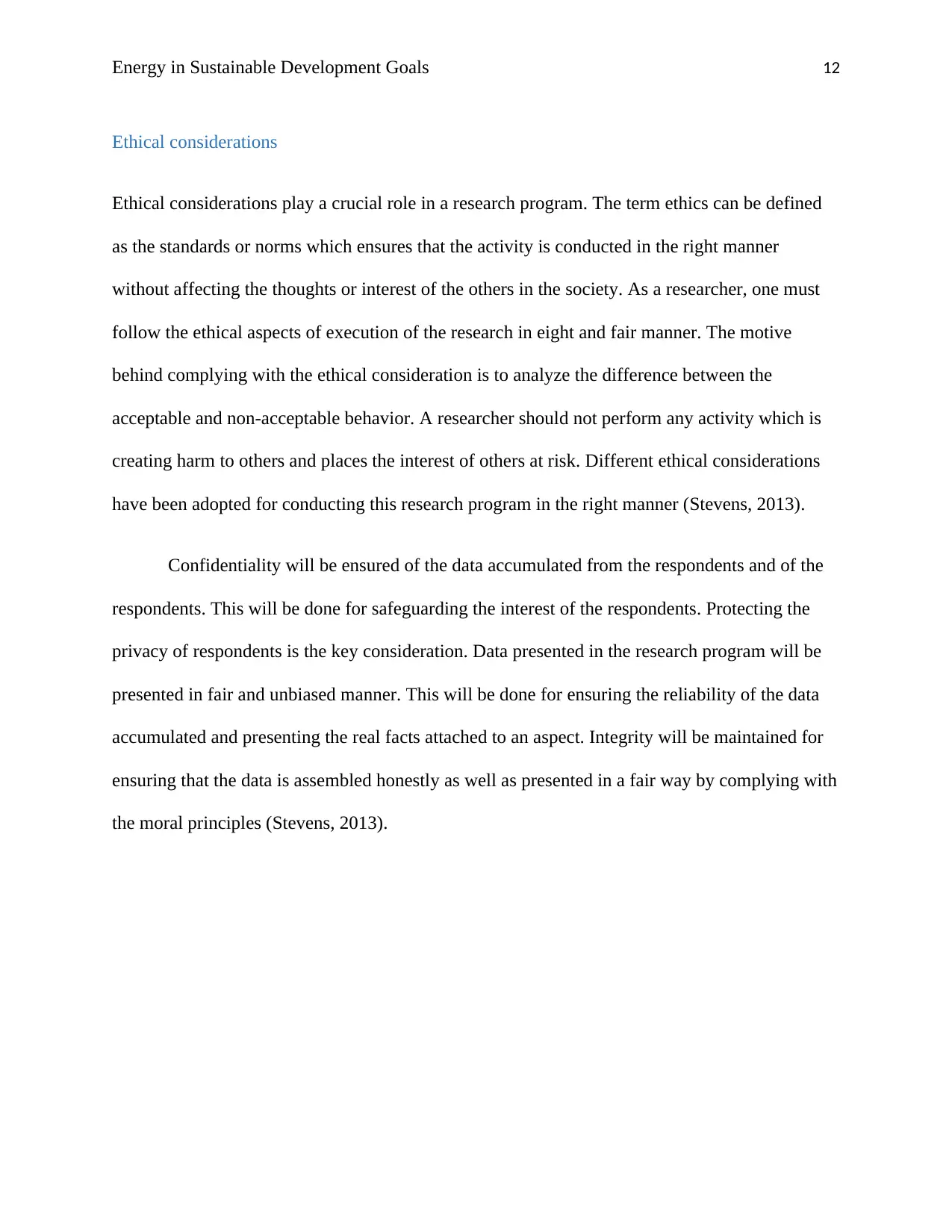
Energy in Sustainable Development Goals 12
Ethical considerations
Ethical considerations play a crucial role in a research program. The term ethics can be defined
as the standards or norms which ensures that the activity is conducted in the right manner
without affecting the thoughts or interest of the others in the society. As a researcher, one must
follow the ethical aspects of execution of the research in eight and fair manner. The motive
behind complying with the ethical consideration is to analyze the difference between the
acceptable and non-acceptable behavior. A researcher should not perform any activity which is
creating harm to others and places the interest of others at risk. Different ethical considerations
have been adopted for conducting this research program in the right manner (Stevens, 2013).
Confidentiality will be ensured of the data accumulated from the respondents and of the
respondents. This will be done for safeguarding the interest of the respondents. Protecting the
privacy of respondents is the key consideration. Data presented in the research program will be
presented in fair and unbiased manner. This will be done for ensuring the reliability of the data
accumulated and presenting the real facts attached to an aspect. Integrity will be maintained for
ensuring that the data is assembled honestly as well as presented in a fair way by complying with
the moral principles (Stevens, 2013).
Ethical considerations
Ethical considerations play a crucial role in a research program. The term ethics can be defined
as the standards or norms which ensures that the activity is conducted in the right manner
without affecting the thoughts or interest of the others in the society. As a researcher, one must
follow the ethical aspects of execution of the research in eight and fair manner. The motive
behind complying with the ethical consideration is to analyze the difference between the
acceptable and non-acceptable behavior. A researcher should not perform any activity which is
creating harm to others and places the interest of others at risk. Different ethical considerations
have been adopted for conducting this research program in the right manner (Stevens, 2013).
Confidentiality will be ensured of the data accumulated from the respondents and of the
respondents. This will be done for safeguarding the interest of the respondents. Protecting the
privacy of respondents is the key consideration. Data presented in the research program will be
presented in fair and unbiased manner. This will be done for ensuring the reliability of the data
accumulated and presenting the real facts attached to an aspect. Integrity will be maintained for
ensuring that the data is assembled honestly as well as presented in a fair way by complying with
the moral principles (Stevens, 2013).
Secure Best Marks with AI Grader
Need help grading? Try our AI Grader for instant feedback on your assignments.
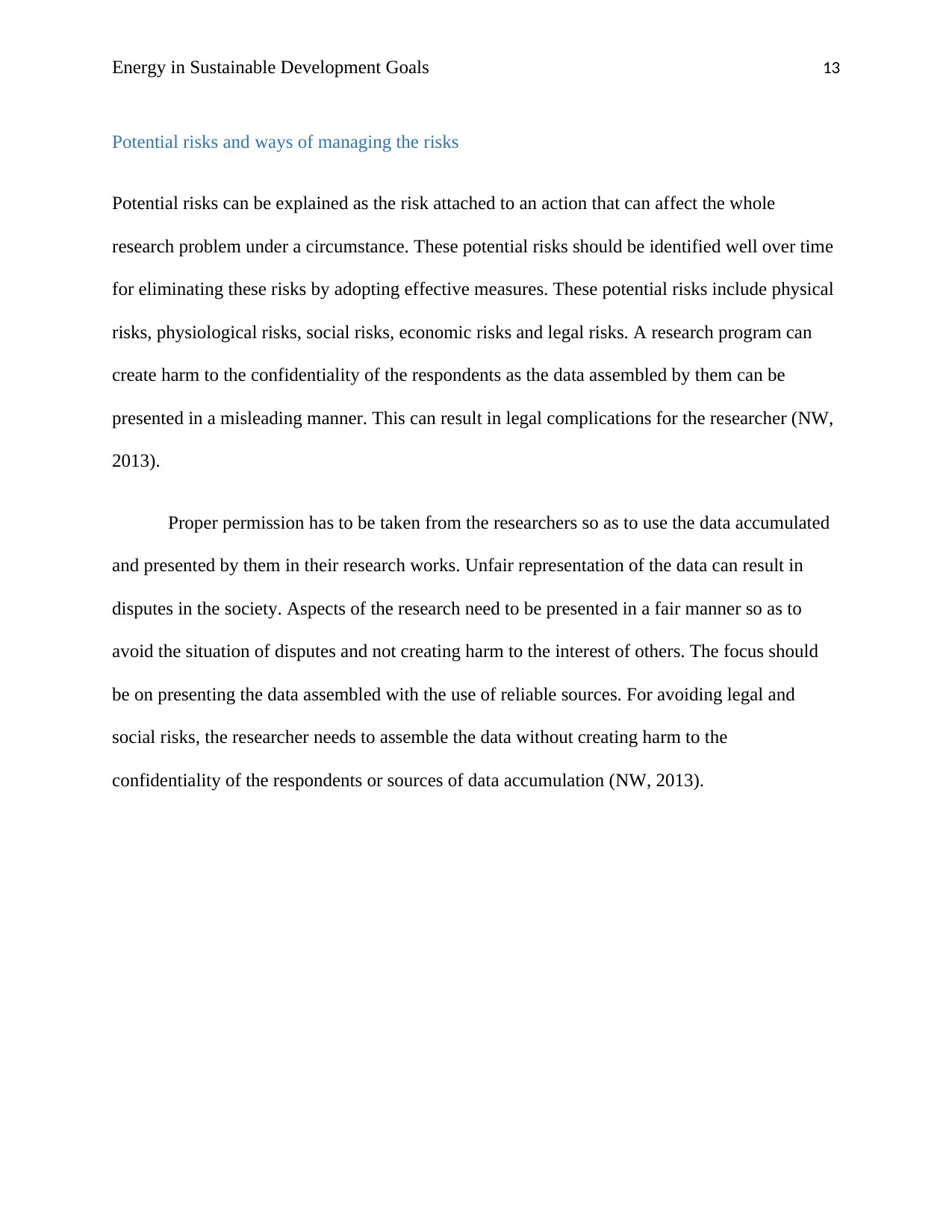
Energy in Sustainable Development Goals 13
Potential risks and ways of managing the risks
Potential risks can be explained as the risk attached to an action that can affect the whole
research problem under a circumstance. These potential risks should be identified well over time
for eliminating these risks by adopting effective measures. These potential risks include physical
risks, physiological risks, social risks, economic risks and legal risks. A research program can
create harm to the confidentiality of the respondents as the data assembled by them can be
presented in a misleading manner. This can result in legal complications for the researcher (NW,
2013).
Proper permission has to be taken from the researchers so as to use the data accumulated
and presented by them in their research works. Unfair representation of the data can result in
disputes in the society. Aspects of the research need to be presented in a fair manner so as to
avoid the situation of disputes and not creating harm to the interest of others. The focus should
be on presenting the data assembled with the use of reliable sources. For avoiding legal and
social risks, the researcher needs to assemble the data without creating harm to the
confidentiality of the respondents or sources of data accumulation (NW, 2013).
Potential risks and ways of managing the risks
Potential risks can be explained as the risk attached to an action that can affect the whole
research problem under a circumstance. These potential risks should be identified well over time
for eliminating these risks by adopting effective measures. These potential risks include physical
risks, physiological risks, social risks, economic risks and legal risks. A research program can
create harm to the confidentiality of the respondents as the data assembled by them can be
presented in a misleading manner. This can result in legal complications for the researcher (NW,
2013).
Proper permission has to be taken from the researchers so as to use the data accumulated
and presented by them in their research works. Unfair representation of the data can result in
disputes in the society. Aspects of the research need to be presented in a fair manner so as to
avoid the situation of disputes and not creating harm to the interest of others. The focus should
be on presenting the data assembled with the use of reliable sources. For avoiding legal and
social risks, the researcher needs to assemble the data without creating harm to the
confidentiality of the respondents or sources of data accumulation (NW, 2013).
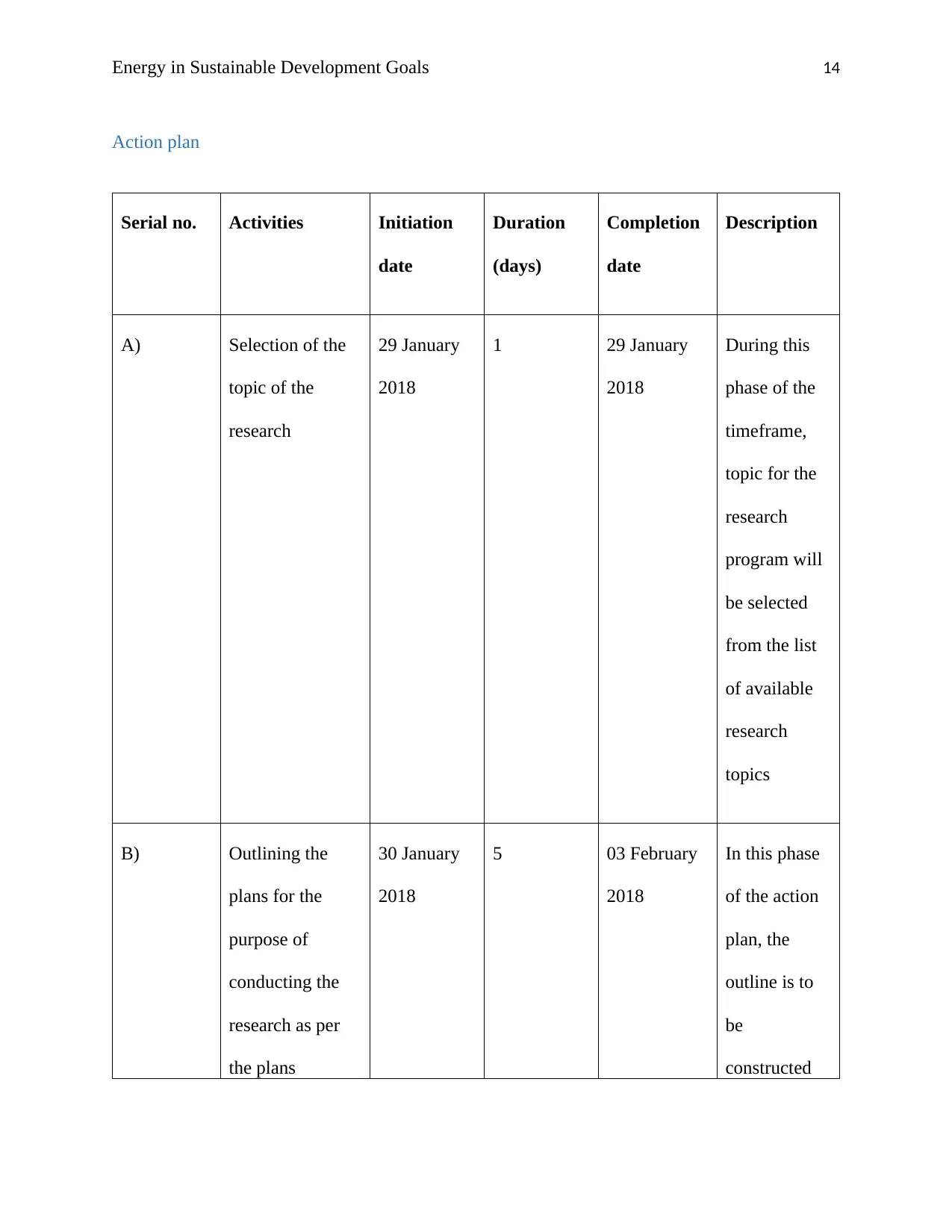
Energy in Sustainable Development Goals 14
Action plan
Serial no. Activities Initiation
date
Duration
(days)
Completion
date
Description
A) Selection of the
topic of the
research
29 January
2018
1 29 January
2018
During this
phase of the
timeframe,
topic for the
research
program will
be selected
from the list
of available
research
topics
B) Outlining the
plans for the
purpose of
conducting the
research as per
the plans
30 January
2018
5 03 February
2018
In this phase
of the action
plan, the
outline is to
be
constructed
Action plan
Serial no. Activities Initiation
date
Duration
(days)
Completion
date
Description
A) Selection of the
topic of the
research
29 January
2018
1 29 January
2018
During this
phase of the
timeframe,
topic for the
research
program will
be selected
from the list
of available
research
topics
B) Outlining the
plans for the
purpose of
conducting the
research as per
the plans
30 January
2018
5 03 February
2018
In this phase
of the action
plan, the
outline is to
be
constructed
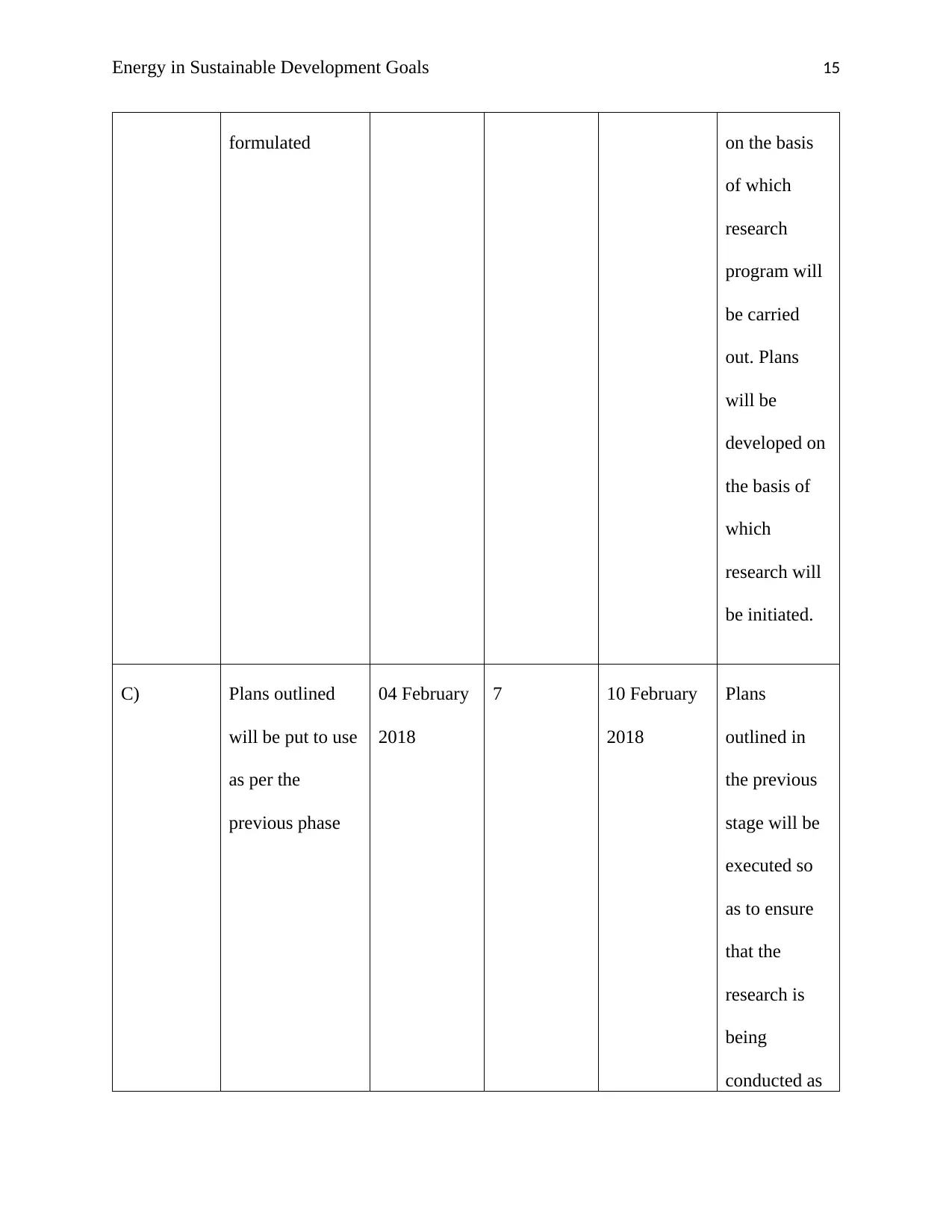
Energy in Sustainable Development Goals 15
formulated on the basis
of which
research
program will
be carried
out. Plans
will be
developed on
the basis of
which
research will
be initiated.
C) Plans outlined
will be put to use
as per the
previous phase
04 February
2018
7 10 February
2018
Plans
outlined in
the previous
stage will be
executed so
as to ensure
that the
research is
being
conducted as
formulated on the basis
of which
research
program will
be carried
out. Plans
will be
developed on
the basis of
which
research will
be initiated.
C) Plans outlined
will be put to use
as per the
previous phase
04 February
2018
7 10 February
2018
Plans
outlined in
the previous
stage will be
executed so
as to ensure
that the
research is
being
conducted as
Paraphrase This Document
Need a fresh take? Get an instant paraphrase of this document with our AI Paraphraser
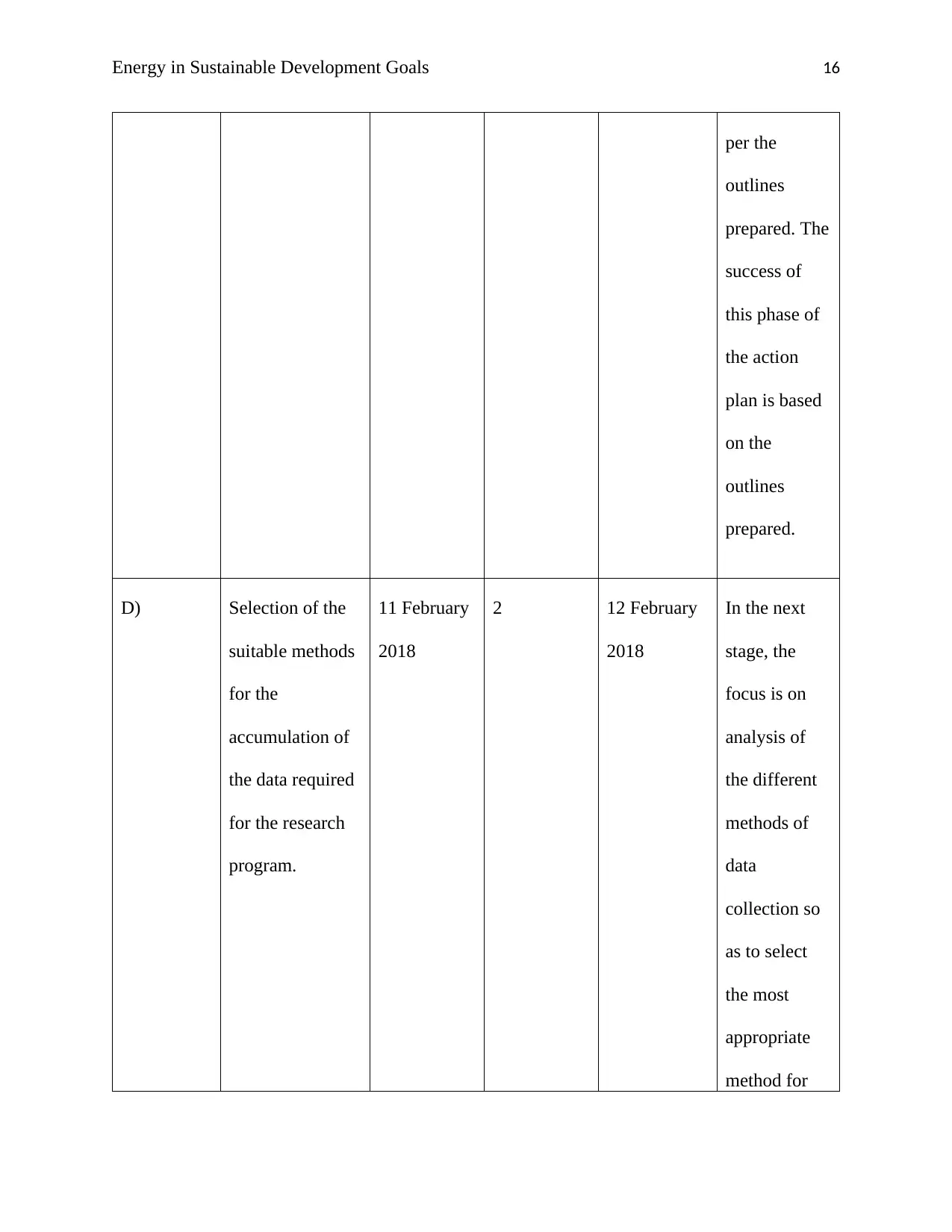
Energy in Sustainable Development Goals 16
per the
outlines
prepared. The
success of
this phase of
the action
plan is based
on the
outlines
prepared.
D) Selection of the
suitable methods
for the
accumulation of
the data required
for the research
program.
11 February
2018
2 12 February
2018
In the next
stage, the
focus is on
analysis of
the different
methods of
data
collection so
as to select
the most
appropriate
method for
per the
outlines
prepared. The
success of
this phase of
the action
plan is based
on the
outlines
prepared.
D) Selection of the
suitable methods
for the
accumulation of
the data required
for the research
program.
11 February
2018
2 12 February
2018
In the next
stage, the
focus is on
analysis of
the different
methods of
data
collection so
as to select
the most
appropriate
method for

Energy in Sustainable Development Goals 17
assembling of
the relevant
data as per
the objectives
and research
questions of
the research.
E) Assembling of
the required data
with the help of
selected methods
13 February
2018
9 21 February
2018
Selected
methods for
data
accumulation
will be put to
use so as to
assemble the
required data.
Quality of the
data is based
on the
methods used
for
accumulation
assembling of
the relevant
data as per
the objectives
and research
questions of
the research.
E) Assembling of
the required data
with the help of
selected methods
13 February
2018
9 21 February
2018
Selected
methods for
data
accumulation
will be put to
use so as to
assemble the
required data.
Quality of the
data is based
on the
methods used
for
accumulation
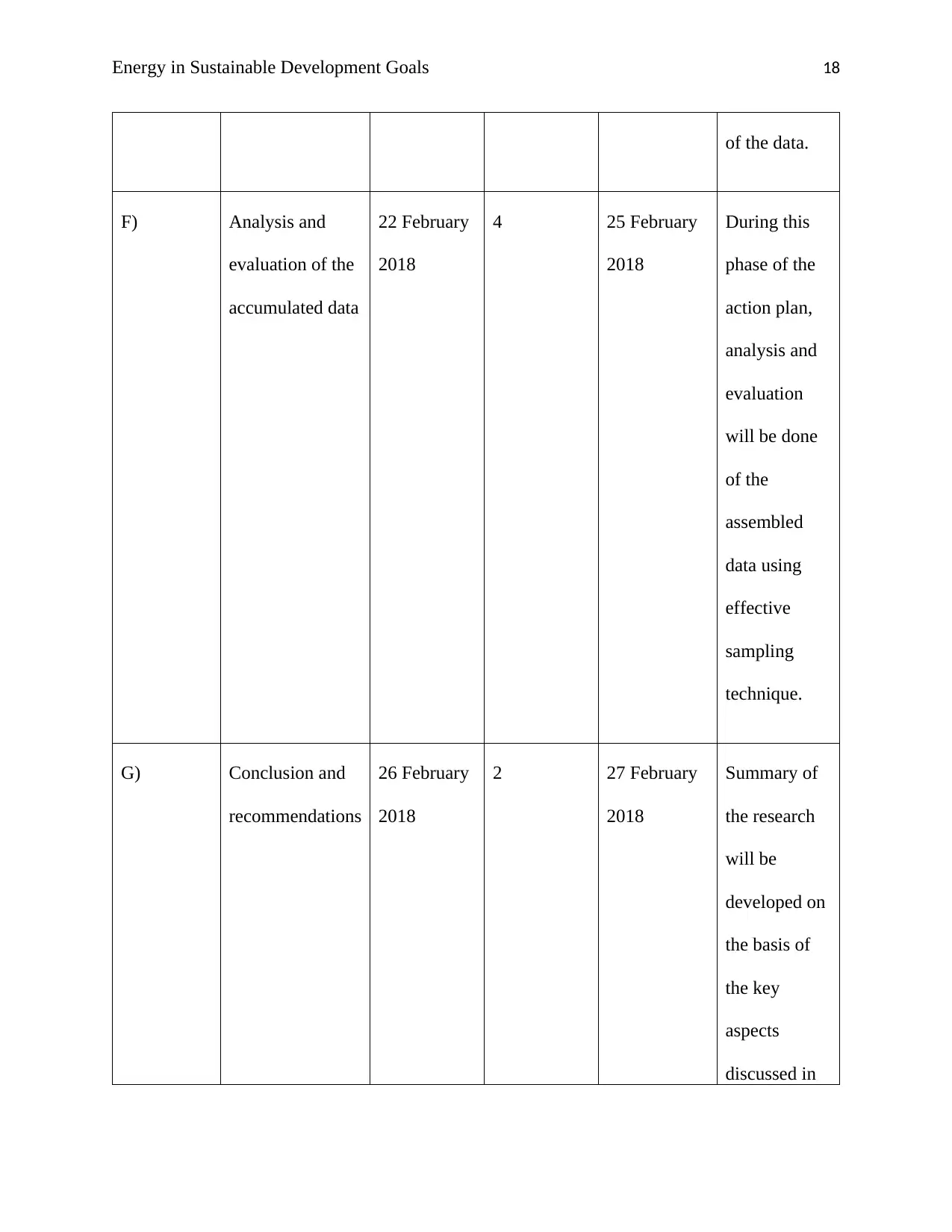
Energy in Sustainable Development Goals 18
of the data.
F) Analysis and
evaluation of the
accumulated data
22 February
2018
4 25 February
2018
During this
phase of the
action plan,
analysis and
evaluation
will be done
of the
assembled
data using
effective
sampling
technique.
G) Conclusion and
recommendations
26 February
2018
2 27 February
2018
Summary of
the research
will be
developed on
the basis of
the key
aspects
discussed in
of the data.
F) Analysis and
evaluation of the
accumulated data
22 February
2018
4 25 February
2018
During this
phase of the
action plan,
analysis and
evaluation
will be done
of the
assembled
data using
effective
sampling
technique.
G) Conclusion and
recommendations
26 February
2018
2 27 February
2018
Summary of
the research
will be
developed on
the basis of
the key
aspects
discussed in
Secure Best Marks with AI Grader
Need help grading? Try our AI Grader for instant feedback on your assignments.
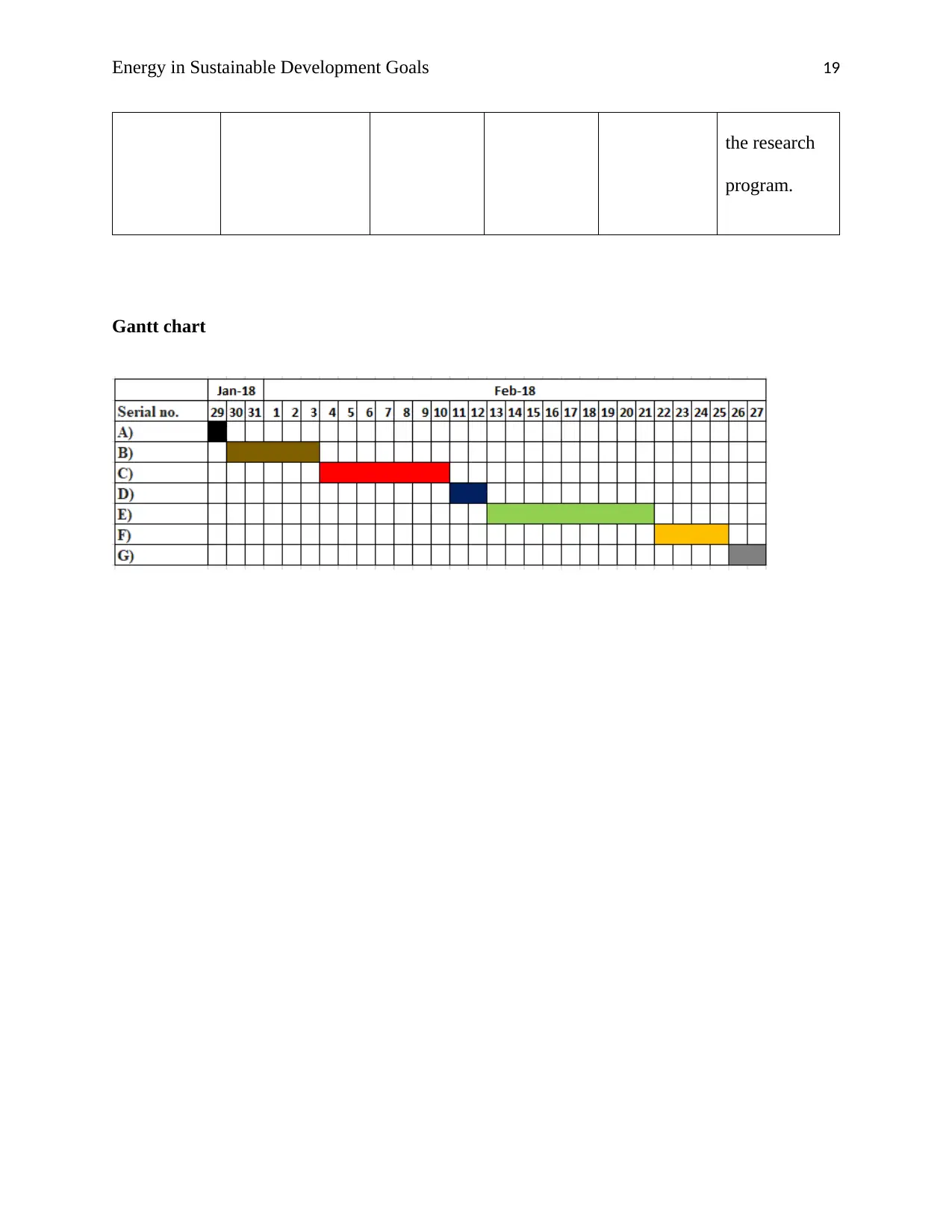
Energy in Sustainable Development Goals 19
the research
program.
Gantt chart
the research
program.
Gantt chart

Energy in Sustainable Development Goals 20
References
Alasuutari, P., 2010, “The rise and relevance of qualitative research”, International journal of
social research methodology, 13 (2), pp. 139-155.
Bhide, A. & Monroy, C. R., 2011, “Energy poverty: A special focus on energy poverty in India
and renewable energy technologies”, Renewable and Sustainable Energy Reviews, 15: pp. 1057–
1066.
Caruth, G. D., 2013, “Demystifying Mixed Methods Research Design: A Review of the
Literature”, Mevlana International Journal of Education, 3 (2).
Goozee, H., 2017, “Energy, poverty and development: a primer for the Sustainable Development
Goals”, International Policy Centre for Inclusive Growth, Working paper, Number 156.
Haq, M., 2014, “A comparative analysis of qualitative and quantitative research methods and a
justification for use of mixed methods in social research”, Annual PhD Conference, University of
Bradford Business School of Management.
ICTSD, 2014, “Climate Change, Trade and Sustainable Energy”, ICTSD.
Jaramillo-Nieves, L. & Río, P. D., 2010, “Contribution of Renewable Energy Sources to the
Sustainable Development of Islands: An Overview of the Literature and a Research Agenda”,
Sustainability, 2, pp. 783-811. DOI: 10.3390/su2030783
Jogulu, U. D. & Pansiri, J., 2011, “Mixed methods: a research design for management doctoral
dissertations”, Management research review, 34 (6), pp. 687-701.
References
Alasuutari, P., 2010, “The rise and relevance of qualitative research”, International journal of
social research methodology, 13 (2), pp. 139-155.
Bhide, A. & Monroy, C. R., 2011, “Energy poverty: A special focus on energy poverty in India
and renewable energy technologies”, Renewable and Sustainable Energy Reviews, 15: pp. 1057–
1066.
Caruth, G. D., 2013, “Demystifying Mixed Methods Research Design: A Review of the
Literature”, Mevlana International Journal of Education, 3 (2).
Goozee, H., 2017, “Energy, poverty and development: a primer for the Sustainable Development
Goals”, International Policy Centre for Inclusive Growth, Working paper, Number 156.
Haq, M., 2014, “A comparative analysis of qualitative and quantitative research methods and a
justification for use of mixed methods in social research”, Annual PhD Conference, University of
Bradford Business School of Management.
ICTSD, 2014, “Climate Change, Trade and Sustainable Energy”, ICTSD.
Jaramillo-Nieves, L. & Río, P. D., 2010, “Contribution of Renewable Energy Sources to the
Sustainable Development of Islands: An Overview of the Literature and a Research Agenda”,
Sustainability, 2, pp. 783-811. DOI: 10.3390/su2030783
Jogulu, U. D. & Pansiri, J., 2011, “Mixed methods: a research design for management doctoral
dissertations”, Management research review, 34 (6), pp. 687-701.
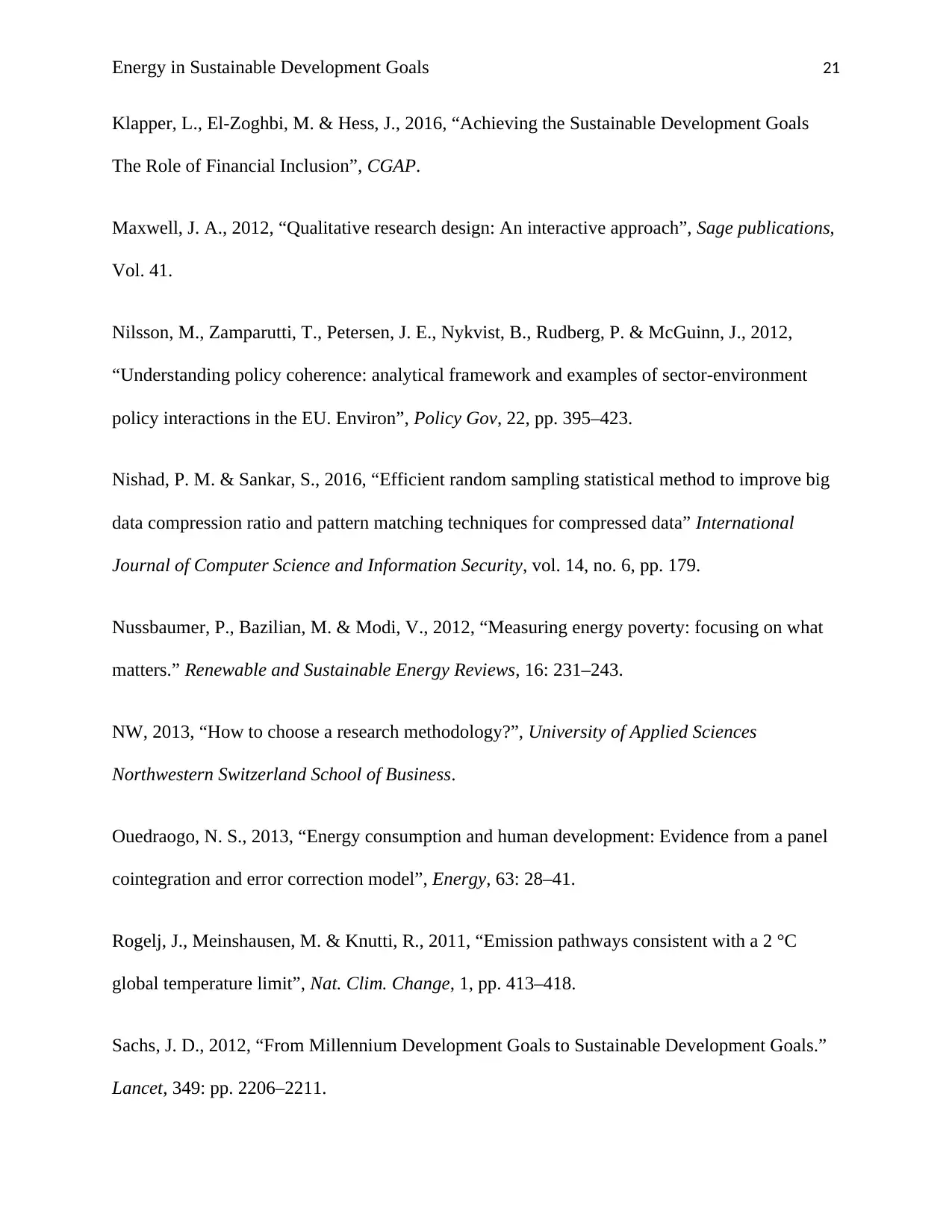
Energy in Sustainable Development Goals 21
Klapper, L., El-Zoghbi, M. & Hess, J., 2016, “Achieving the Sustainable Development Goals
The Role of Financial Inclusion”, CGAP.
Maxwell, J. A., 2012, “Qualitative research design: An interactive approach”, Sage publications,
Vol. 41.
Nilsson, M., Zamparutti, T., Petersen, J. E., Nykvist, B., Rudberg, P. & McGuinn, J., 2012,
“Understanding policy coherence: analytical framework and examples of sector-environment
policy interactions in the EU. Environ”, Policy Gov, 22, pp. 395–423.
Nishad, P. M. & Sankar, S., 2016, “Efficient random sampling statistical method to improve big
data compression ratio and pattern matching techniques for compressed data” International
Journal of Computer Science and Information Security, vol. 14, no. 6, pp. 179.
Nussbaumer, P., Bazilian, M. & Modi, V., 2012, “Measuring energy poverty: focusing on what
matters.” Renewable and Sustainable Energy Reviews, 16: 231–243.
NW, 2013, “How to choose a research methodology?”, University of Applied Sciences
Northwestern Switzerland School of Business.
Ouedraogo, N. S., 2013, “Energy consumption and human development: Evidence from a panel
cointegration and error correction model”, Energy, 63: 28–41.
Rogelj, J., Meinshausen, M. & Knutti, R., 2011, “Emission pathways consistent with a 2 °C
global temperature limit”, Nat. Clim. Change, 1, pp. 413–418.
Sachs, J. D., 2012, “From Millennium Development Goals to Sustainable Development Goals.”
Lancet, 349: pp. 2206–2211.
Klapper, L., El-Zoghbi, M. & Hess, J., 2016, “Achieving the Sustainable Development Goals
The Role of Financial Inclusion”, CGAP.
Maxwell, J. A., 2012, “Qualitative research design: An interactive approach”, Sage publications,
Vol. 41.
Nilsson, M., Zamparutti, T., Petersen, J. E., Nykvist, B., Rudberg, P. & McGuinn, J., 2012,
“Understanding policy coherence: analytical framework and examples of sector-environment
policy interactions in the EU. Environ”, Policy Gov, 22, pp. 395–423.
Nishad, P. M. & Sankar, S., 2016, “Efficient random sampling statistical method to improve big
data compression ratio and pattern matching techniques for compressed data” International
Journal of Computer Science and Information Security, vol. 14, no. 6, pp. 179.
Nussbaumer, P., Bazilian, M. & Modi, V., 2012, “Measuring energy poverty: focusing on what
matters.” Renewable and Sustainable Energy Reviews, 16: 231–243.
NW, 2013, “How to choose a research methodology?”, University of Applied Sciences
Northwestern Switzerland School of Business.
Ouedraogo, N. S., 2013, “Energy consumption and human development: Evidence from a panel
cointegration and error correction model”, Energy, 63: 28–41.
Rogelj, J., Meinshausen, M. & Knutti, R., 2011, “Emission pathways consistent with a 2 °C
global temperature limit”, Nat. Clim. Change, 1, pp. 413–418.
Sachs, J. D., 2012, “From Millennium Development Goals to Sustainable Development Goals.”
Lancet, 349: pp. 2206–2211.
Paraphrase This Document
Need a fresh take? Get an instant paraphrase of this document with our AI Paraphraser
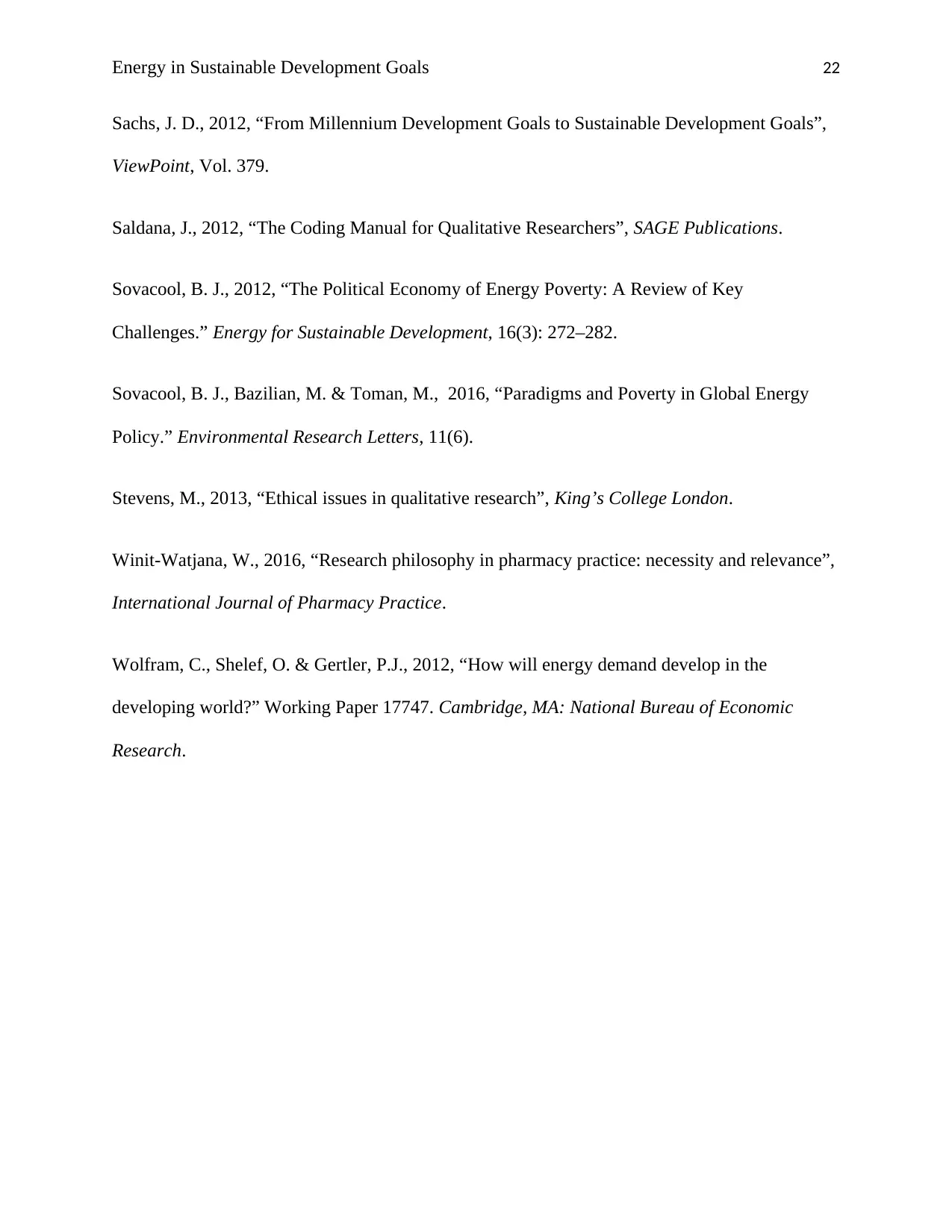
Energy in Sustainable Development Goals 22
Sachs, J. D., 2012, “From Millennium Development Goals to Sustainable Development Goals”,
ViewPoint, Vol. 379.
Saldana, J., 2012, “The Coding Manual for Qualitative Researchers”, SAGE Publications.
Sovacool, B. J., 2012, “The Political Economy of Energy Poverty: A Review of Key
Challenges.” Energy for Sustainable Development, 16(3): 272–282.
Sovacool, B. J., Bazilian, M. & Toman, M., 2016, “Paradigms and Poverty in Global Energy
Policy.” Environmental Research Letters, 11(6).
Stevens, M., 2013, “Ethical issues in qualitative research”, King’s College London.
Winit-Watjana, W., 2016, “Research philosophy in pharmacy practice: necessity and relevance”,
International Journal of Pharmacy Practice.
Wolfram, C., Shelef, O. & Gertler, P.J., 2012, “How will energy demand develop in the
developing world?” Working Paper 17747. Cambridge, MA: National Bureau of Economic
Research.
Sachs, J. D., 2012, “From Millennium Development Goals to Sustainable Development Goals”,
ViewPoint, Vol. 379.
Saldana, J., 2012, “The Coding Manual for Qualitative Researchers”, SAGE Publications.
Sovacool, B. J., 2012, “The Political Economy of Energy Poverty: A Review of Key
Challenges.” Energy for Sustainable Development, 16(3): 272–282.
Sovacool, B. J., Bazilian, M. & Toman, M., 2016, “Paradigms and Poverty in Global Energy
Policy.” Environmental Research Letters, 11(6).
Stevens, M., 2013, “Ethical issues in qualitative research”, King’s College London.
Winit-Watjana, W., 2016, “Research philosophy in pharmacy practice: necessity and relevance”,
International Journal of Pharmacy Practice.
Wolfram, C., Shelef, O. & Gertler, P.J., 2012, “How will energy demand develop in the
developing world?” Working Paper 17747. Cambridge, MA: National Bureau of Economic
Research.
1 out of 23
Related Documents
Your All-in-One AI-Powered Toolkit for Academic Success.
+13062052269
info@desklib.com
Available 24*7 on WhatsApp / Email
![[object Object]](/_next/static/media/star-bottom.7253800d.svg)
Unlock your academic potential
© 2024 | Zucol Services PVT LTD | All rights reserved.





